Estadio Santiago Bernabéu
Updated: 30.04.2025
| Target capacity | 81 000 |
|---|---|
| Capacity before works | 81 044 |
| Country | Spain |
| City | Madrid |
| Clubs | Real Madrid CF |
| Category | Construction in progress |
| Construction | 2019–2024 |
| Cost | €1.17 B ($1.27 B) |
| Design | GMP Architekten, L35 Arquitectos, Ribas&Ribas |
| Contractor | FCC Construcción |
| Design time | 2013 / 2016 |
Advertisement
Estadio Santiago Bernabéu – construction description
How did the extension of Estadio Santiago Bernabéu come about?
Estadio Santiago Bernabéu opened in 1947 and the venue has since undergone four major expansions, as well as numerous smaller upgrades. The stadium ranks among the most important and recognisable sporting venues in Europe and the world, and its host, Real Madrid, is one of the most popular and successful football clubs in the world.
The next major expansion of Estadio Santiago Bernabéu, now in its fifth year, to significantly upgrade the stadium and radically change the exterior, has become one of the priorities of Real Madrid president Florentino Pérez, especially after he took up the role for the second time in 2009.
When was the concept of expanding Estadio Santiago Bernabéu conceived?
In June 2012, the club announced the launch of an international competition for the architectural concept for the extension of Estadio Santiago Bernabéu. Renowned studios from around the world were invited to participate in the competition. On September 30, 2012, at a general meeting of the club's members, Pérez presented four concepts, from which the vision prepared by gmp Architekten, L35 Arquitectos and Ribas & Ribas Arquitectos was selected (the selection was announced on January 31, 2014).
The realization of the project was delayed by problems over land ownership around the stadium. In the meantime, the details of the architectural concept were considered. The final design lacked a hotel and a shopping center, and the shape of the stadium's façade on the east side took a more simplified form. Further changes to the design were announced after the project had already started, the most important of which was the addition of a system for folding the turf into segments and retracting them underground.
What is the brief for the extension of Estadio Santiago Bernabéu?
The architectural concept for the extension of Estadio Santiago Bernabéu can be seen on a separate subpage
The redevelopment of Estadio Santiago Bernabéu is set to significantly change its external appearance. The venue will noticeably widen its outline and gain a completely new futuristic facade with distinctive metal slats, as well as a roof that will cover all the stands and be equipped with an opening/closing section above the pitch. A panoramic video screen will be installed under the roof.
The building will be extended to the east and west, gaining new usable space. The existing interiors will also undergo upgrades. The external spiral towers on the west side will be replaced by new ones; while all four corner towers will be obscured by a new façade.
The layout of the stands will be largely retained. The biggest changes will take place in the eastern stand, where an additional floor will be created. The two side towers on the sides of the upper part of the stand will also be removed. The space created by the removal of the towers will be used to slightly extend the third floor of the stand.
The stadium will also receive new folding seats in dark blue. Three glass pavilions will be built on the crown of the stands, as well as a panoramic terrace (skywalk). The capacity of the venue will not change much after the upgrade.
One of the major projects will be the construction of a turf folding system, which will be divided into six segments and stored in a 30 m deep storage area underneath the pitch.
The La Esquina del Bernabéu shopping center and office annex next door will disappear from the stadium's surroundings. However, there are plans to increase the number of underground car parks. In addition, the city plans to extend the nearby metro station.
The extension of Estadio Santiago Bernabéu will completely change the image of the stadium, as well as the club itself. The new Bernabéu is to be associated with modernity, as well as reflecting Real's greatness and ambition. The modernisation will help place the venue among the world's elite. Visitor comfort will be significantly improved and the stadium will have greater commercial capacity and be able to attract more major events.
How much is Estadio Santiago Bernabéu expansion expected to cost?
Initial estimates put the cost of the upgrade at €300-400 million, and when work began it was expected to be €575 million. A loan for this amount was obtained from US financial institutions (Bank of America and JP Morgan). After the scope of work was extended to include the turf folding system, another loan of €225 million was taken out, bringing the expenditure on the upgrade to $800 million.
However, costs continued to rise, heavily influenced by the COVID-19 pandemic and the war in Ukraine, as well as further design changes. In November 2023, the club approved taking out another loan, to the tune of €370 million, and the cost of the entire project had already risen to €1.17 billion, making the venture one of the most expensive stadium upgrades in history.
How is the extension of Estadio Santiago Bernabéu progressing?
The scope of the work being carried out at Estadio Santiago Bernabéu is extensive and consists of many different aspects. The facility will be extended, with a completely new façade and roof (with a lockable section above the pitch), and changes will also be made to the stands and existing facilities. The stadium will be enhanced with a turf folding system, and visible changes will also take place in the surrounding area.
As the redevelopment is multi-faceted, work on the various tasks is taking place simultaneously. Matters are complicated by the need to maintain the functionality of the facility, although here, paradoxically, things have been made somewhat easier by the COVID-19 pandemic, for which Real did not play at Bernabéu for a year and a half.
When did the extension of Estadio Santiago Bernabéu begin?
Four companies, FCC, Ferrovial, Acciona and San José, were invited to tender for the main contractor for the works and submitted their bids on February 15, 2019. On May 8, 2019, Real announced the selection of FCC Construcción. Work began the same month.
Was Estadio Santiago Bernabéu shut down for the upgrade?
One of the aims of the redevelopment was to ensure the stadium's continuous operation. The work was to be carried out in such a way that it did not interfere with Real's ability to play matches at their venue and was to be intensified during periods between games, such as in the summer. However, it was natural to reckon with temporary capacity constraints, minor changes to the competition calendar and other inconveniences.
In March 2020, following the outbreak of the COVID-19 pandemic, league games were suspended; when they resumed in June, without the public, Real decided to move to their reserve venue, Estadio Alfredo di Stefano, to make Estadio Santiago Bernabéu fully accessible to the construction teams. In addition, during the pandemic the stadium was used as a warehouse for sanitary materials.
Due to the pandemic, the builders were given an additional year and a half when they were able to work on the stadium expansion without match restrictions (Real returned to Estadio Santiago Bernabéu in September 2021). It was still possible to visit the stadium for most of the duration of the redevelopment.
When was the adjacent to the Estadio Santiago Bernabéu shopping center demolished and the underground car parks enlarged?
One of the tasks that was tackled early on was the demolition of La Esquina del Bernabéu shopping center, located near the south-east corner of the stadium. The demolition of the building lasted until the autumn of 2019, after which the demolition of the underground car park underneath was also started in order to enlarge it (from three to five storeys).
Once the car park was demolished, dredging of the pit began, which was completed in the summer of 2020, and then construction of the new, enlarged car park began (an extension of the underground work also included the construction of a logistics tunnel to encircle the entire stadium). Once above ground, work was carried out in 2021 to tidy up the square above the car park and create a new square in this location. This work continued in subsequent years, but was not completed until 2024.
When was the old roof at Estadio Santiago Bernabéu demolished?
In the summer of 2019, the first works towards the demolition of the old roof over the stands began. The first more visible changes could only be seen at the end of 2019, when the edges of the roof began to disappear. At the beginning of 2020, the removal of the sheathing had already begun, and the entire roof was removed by the summer of 2020, temporarily still leaving (until the summer of 2021) the trussed beam (initially including lighting) that had previously supported the roof over the east stand.
When were the new external towers on the west side of Estadio Santiago Bernabéu built?
Construction of the new external towers on the west side began in the second half of 2019, but the towers did not begin to go up until spring 2020. By summer 2020, the main steel structure of the new towers was ready, allowing the installation of the roof girders for which the towers would provide support. The finishing of the new towers continued in the following years. The old towers standing nearby were demolished in the summer of 2021.
When was the new roof on Estadio Santiago Bernabéu made?
When were the girders of the new roof at Estadio Santiago Bernabéu installed?
The main load-bearing elements of the new roof structure were to be two girders passing over the stands behind the goals. The girders were to rest on four supports: on the west side these were to be the two new external towers, and on the west it was decided to erect two steel pillars.
The main steel structure of the new towers on the west side was ready in summer 2020, and the two pillars on the east side were also built in summer 2020, allowing the girders to be assembled. The girders were assembled by adding sections until they were fully connected, from July to October 2020.
When was the entire roof frame for Estadio Santiago Bernabéu completed?
Once the girders had been installed, it was possible to add further sections of the roof structure. The first elements appeared in the north and south, above the rear parts of the stands behind the goals.
As well as being the main structural element of the roof, the girders had another important role during construction, serving as guides for the four longitudinal beams.
The longitudinal beams were assembled in front of the stadium, then lifted and hooked up to special trolleys that could slide along the girders. This allowed the beams to be dragged to their final position, where they were permanently mounted. In order to streamline the operation, the girders were initially longer and were shortened to the appropriate size at the end of 2021, after all the beams had already been installed.
The installation of all major components of the steel roof frame was completed on December 8, 2022.
When was the sheathing for the new roof at Estadio Santiago Bernabéu made?
The first elements of the sheathing appeared over the stands behind the goals in the summer of 2021, and over the east and west stands in December 2021. In the summer of 2022, the first decorative slats were installed on the surface. The stands were mostly covered in early 2023, finishing work on the stadium cover was still being carried out in the second half of 2023.
When was the roof closing and opening system installed at Estadio Santiago Bernabéu?
The roof began to be fitted with movable trusses in December 2022. The first tests of the membrane stretching and roof closure were carried out in the second half of August 2023.
When was the new video screen installed at Estadio Santiago Bernabéu?
The metal frame of the new circular video screen began to be installed under the roof in July 2023. By the end of 2023, most of the LED panels had already been installed (except for the corner sections) and testing of the screens had begun.
When were the stands at Estadio Santiago Bernabéu expanded?
When was the east stand at Estadio Santiago Bernabéu expanded?
At the end of 2019, the demolition of the two towers that were located on the sides of the east stand (in the upper part) began. Demolition was completed in the summer of 2020, although a steel structure was still left in place, which was not removed until the summer of 2021.
In place of the demolished towers, new short sections of stands began to be built in autumn 2021, extending the third tier slightly. In early 2022, the superstructure of an additional tier on the east stand also began.
The new tier in the east stand was made available to spectators for the first time during the first home game of the 2023/24 season ( September 2, 2023 against Getafe CF). Additional corner sections of the stand were partially available already in spring 2023.
Why was the lower tier of stands at Estadio Santiago Bernabéu rebuilt?
During the modernization of the Estadio Santiago Bernabéu, the lower tier of stands was also being rebuilt, making it a common sight during Real's matches to see large sections of the lower tier covered with sheets.
This was not due to the intention to rebuild these stands as such, but rather due to the need to carry out other tasks as part of the project, e.g. a movable section of the pitch was hidden under the lower part of the west stand, and the temporary demolition of a section of the east stand made it possible to reinforce the railway tunnel running under the pitch.
When were the seats at Estadio Santiago Bernabéu replaced?
One of the aims of the modernization of Estadio Santiago Bernabéu is to replace all the seats in the stands with new folding ones, which will be wider and more comfortable. The new seats are also to feature a darker shade of blue.
Although new chairs had already been installed in places, the mass replacement was not carried out until the second half of 2023. The replacement was delayed for fear that the ongoing work could lead to damage to the new seats. In addition to replacing the seats, the stairs will also be repainted, from their current orange color to gray.
When did the glass pavilions appear above Estadio Santiago Bernabéu stands?
The three glass pavilions on the top of the stands (two in the eastern corners and one, wider, in the west) appeared during the 2023 summer break, although work was still being carried out inside them in the following months.
When were Estadio Santiago Bernabéu's facilities expanded?
The extension of Estadio Santiago Bernabéu to the east began in spring 2021. Construction of the new utility areas to the west began in the second half of 2021 and work is still continuing.
How was the turf folding system developed at Estadio Santiago Bernabéu?
A turf folding system was not in the original plans for the project, even when it was already moving forward in 2019. Information about plans to build such a system did not appear until May 2020. This was a very significant development, requiring the design of a complex system of mechanisms, as well as the construction of a huge underground storage facility.
When the plans to build this system were first announced in May 2020, the first work on it also began. First, the lower tier of the west stand began to be dismantled – this was necessary because one of the movable turf segments was to be located under this stand.
Work on the west stand continued in the following months, meanwhile, in February 2021, the turf was dug up for the next stages of the construction of the system, which required the creation of a deep excavation under the western part of the pitch and the concreting of the surface of the remaining area between the stands.
In spring 2021, work began on the excavation along the western stand. In the summer of 2021, the top layer of the railway tunnel that runs under the eastern part of the pitch was also excavated. It was then possible to see for oneself that this was not a myth and the tunnel does indeed run just under Bernabéu's turf.
The tunnel was dug up to make the necessary reinforcements before the surface could be concreted. To do this, it was also necessary to demolish a section of the lower tier of the east stand.
The surface of the pitch was concreted before the start of the 2021/22 season. The excavation on the west side was covered with a temporary ceiling, under which the deepening continued in the following months. On the surface, meanwhile, the turf was laid so that Real could return to its ground after the summer break.
During the 2021/22 season, work was carried out to restore the lower level of the west stand, as well as to dredge a pit for a storage area for turf segments. During the 2022/23 season, further work on the storage area (hypogeum) continued and the first tests of the turf folding system did not take place until the summer break in 2023.
What incidents occurred during the expansion of Estadio Santiago Bernabéu?
No major incidents were reported during the extension of Estadio Santiago Bernabéu. The most serious incident was a fire that broke out on May 26, 2021 on one of the outer towers, during the installation of insulation material. Clouds of smoke rose above the stadium at the time and the fire brigade arrived on the scene and brought the situation under control within 15 minutes. No one was hurt by the fire and there was little material damage.
Will additional car parks be built around Estadio Santiago Bernabéu?
In addition to the extension of the car park under the shopping center, a separate development is to be the construction of two further underground car parks near the stadium. One of these (for 617 vehicles) is to extend under Calle del Padre Damián and the other (for 1,229 vehicles) is to be located behind the west stand, along Paseo de la Castellana, where another square is to be created on the surface. In addition, the city is planning to redevelop the nearby metro station, which is to triple in size at a cost of €68 million.
When will Estadio Santiago Bernabéu expansion be completed?
Following the signing of the contract in May 2019, the contractor, FCC Construcción, has been given 39 months to complete the job, until August 2022, and an additional four months to complete the work outside the stadium. According to this timetable, the redevelopment would have been completed in December 2022, in time for the stadium's 75th anniversary.
The original deadline could not be met. This was affected by the war in Ukraine and changes made to the project, as well as the COVID-19 pandemic, although this one also sped up some of the processes, as Real did not play matches at Estadio Santiago Bernabéu for a year and a half, giving the builders more leeway.
As the work had clearly extended, a new opening date was set for December 23, 2023 (the stadium is actually open all the time, but the club intends to hold a special ceremony to mark the completion of the work). However, this date could not be met either, and the reinauguration is now not expected until after the end of 2023/24 season.
Advertisement
Pictures
30.04.2025
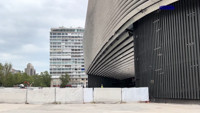
30.04.2025 © Madrid1902 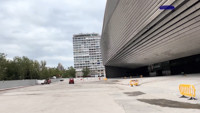
30.04.2025 © Madrid1902 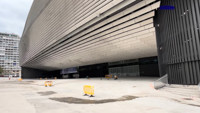
30.04.2025 © Madrid1902 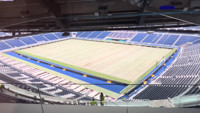
30.04.2025 © Madrid1902 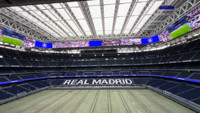
30.04.2025 © Madrid1902 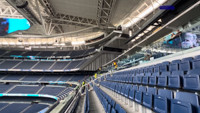
30.04.2025 © Madrid1902
20.02.2025
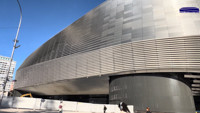
20.02.2025 © Madrid1902 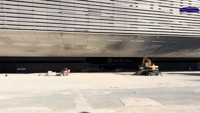
20.02.2025 © Madrid1902 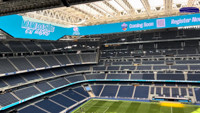
20.02.2025 © Madrid1902
24.01.2025
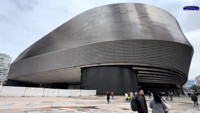
24.01.2025 © Madrid1902 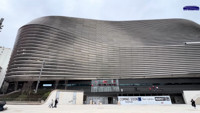
24.01.2025 © Madrid1902 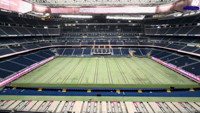
24.01.2025 © Madrid1902
17.12.2024
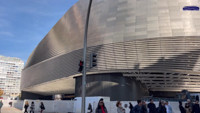
17.12.2024 © Madrid1902 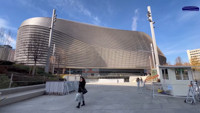
17.12.2024 © Madrid1902
14.11.2024
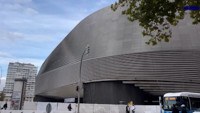
14.11.2024 © Madrid1902 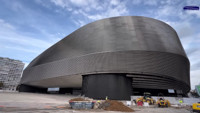
14.11.2024 © Madrid1902 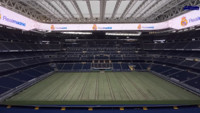
14.11.2024 © Madrid1902
11.10.2024
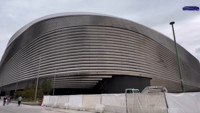
11.10.2024 © Madrid1902 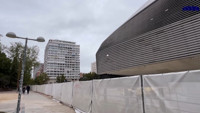
11.10.2024 © Madrid1902 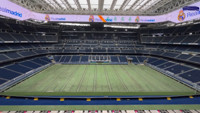
11.10.2024 © Madrid1902
23.09.2024
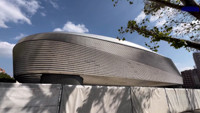
23.09.2024 © Madrid1902 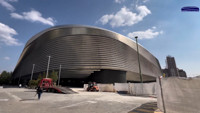
23.09.2024 © Madrid1902 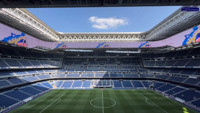
23.09.2024 © Madrid1902
26.08.2024
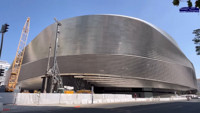
26.08.2024 © Madrid1902 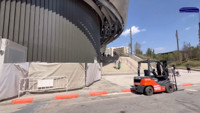
26.08.2024 © Madrid1902 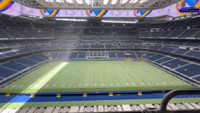
26.08.2024 © Madrid1902
19.07.2024

19.07.2024 © Madrid1902 
19.07.2024 © Madrid1902 
19.07.2024 © Madrid1902 
19.07.2024 © Madrid1902 
19.07.2024 © Madrid1902 
19.07.2024 © Madrid1902
24.06.2024

24.06.2024 © Madrid1902 
24.06.2024 © Madrid1902 
24.06.2024 © Madrid1902
22.05.2024

22.05.2024 © Madrid1902 
22.05.2024 © Madrid1902 
22.05.2024 © Madrid1902 
22.05.2024 © Madrid1902 
22.05.2024 © Madrid1902 
22.05.2024 © Madrid1902
08.05.2024

08.05.2024 © Madrid1902 
08.05.2024 © Madrid1902 
08.05.2024 © Madrid1902 
08.05.2024 © Madrid1902 
08.05.2024 © Madrid1902
16.04.2024

16.04.2024 © Madrid1902 
16.04.2024 © Madrid1902 
16.04.2024 © Madrid1902 
16.04.2024 © Madrid1902 
16.04.2024 © Madrid1902 
16.04.2024 © Madrid1902
27.03.2024

27.03.2024 © Madrid1902 
27.03.2024 © Madrid1902 
27.03.2024 © Madrid1902 
27.03.2024 © Madrid1902 
27.03.2024 © Madrid1902 
27.03.2024 © Madrid1902
05.03.2024

05.03.2024 © Madrid1902
10.02.2024

10.02.2024 © Madrid1902 
10.02.2024 © Madrid1902 
10.02.2024 © Madrid1902
13.01.2024

13.01.2024 © Alecaom 
13.01.2024 © Alecaom 
13.01.2024 © Alecaom 
13.01.2024 © Alecaom 
13.01.2024 © Alecaom 
13.01.2024 © Alecaom
08.01.2024

08.01.2024 © Madrid1902 
08.01.2024 © Madrid1902 
08.01.2024 © Madrid1902 
08.01.2024 © Madrid1902 
08.01.2024 © Madrid1902 
08.01.2024 © Madrid1902
15.12.2023

15.12.2023 © Madrid1902 
15.12.2023 © Madrid1902 
15.12.2023 © Madrid1902 
15.12.2023 © Madrid1902 
15.12.2023 © Madrid1902 
15.12.2023 © Madrid1902
14.12.2023

14.12.2023 © Alecaom
11.12.2023

11.12.2023 © Madrid1902 
11.12.2023 © Madrid1902 
11.12.2023 © Madrid1902
21.11.2023

21.11.2023 © Madrid1902 
21.11.2023 © Madrid1902 
21.11.2023 © Madrid1902 
21.11.2023 © Madrid1902 
21.11.2023 © Madrid1902 
21.11.2023 © Madrid1902
06.11.2023

06.11.2023 © Madrid1902 
06.11.2023 © Madrid1902 
06.11.2023 © Madrid1902 
06.11.2023 © Madrid1902 
06.11.2023 © Madrid1902 
06.11.2023 © Madrid1902
23.10.2023

23.10.2023 © Madrid1902 
23.10.2023 © Madrid1902 
23.10.2023 © Madrid1902 
23.10.2023 © Madrid1902 
23.10.2023 © Madrid1902 
23.10.2023 © Madrid1902 
23.10.2023 © Madrid1902 
23.10.2023 © Madrid1902 
23.10.2023 © Madrid1902
02.10.2023

02.10.2023 © Madrid1902 
02.10.2023 © Madrid1902 
02.10.2023 © Madrid1902 
02.10.2023 © Madrid1902 
02.10.2023 © Madrid1902 
02.10.2023 © Madrid1902 
02.10.2023 © Madrid1902 
02.10.2023 © Madrid1902 
02.10.2023 © Madrid1902
19.09.2023

19.09.2023 © Madrid1902 
19.09.2023 © Madrid1902 
19.09.2023 © Madrid1902
23.08.2023

23.08.2023 © Madrid1902 
23.08.2023 © Madrid1902 
23.08.2023 © Madrid1902 
23.08.2023 © Madrid1902 
23.08.2023 © Madrid1902 
23.08.2023 © Madrid1902 
23.08.2023 © Madrid1902 
23.08.2023 © Madrid1902 
23.08.2023 © Madrid1902
09.08.2023

09.08.2023 © Madrid1902 
09.08.2023 © Madrid1902 
09.08.2023 © Madrid1902 
09.08.2023 © Madrid1902 
09.08.2023 © Madrid1902 
09.08.2023 © Madrid1902
27.07.2023

27.07.2023 © Alecaom 
27.07.2023 © Alecaom 
27.07.2023 © Alecaom 
27.07.2023 © Alecaom 
27.07.2023 © Alecaom 
27.07.2023 © Alecaom 
27.07.2023 © Alecaom 
27.07.2023 © Alecaom 
27.07.2023 © Alecaom
21.07.2023

21.07.2023 © Nuevo Estadio Bernabeu 
21.07.2023 © Nuevo Estadio Bernabeu 
21.07.2023 © Nuevo Estadio Bernabeu 
21.07.2023 © Nuevo Estadio Bernabeu 
21.07.2023 © Nuevo Estadio Bernabeu 
21.07.2023 © Nuevo Estadio Bernabeu
10.07.2023

10.07.2023 © Nuevo Estadio Bernabeu 
10.07.2023 © Nuevo Estadio Bernabeu 
10.07.2023 © Nuevo Estadio Bernabeu 
10.07.2023 © Nuevo Estadio Bernabeu 
10.07.2023 © Nuevo Estadio Bernabeu 
10.07.2023 © Nuevo Estadio Bernabeu 
10.07.2023 © Nuevo Estadio Bernabeu 
10.07.2023 © Nuevo Estadio Bernabeu 
10.07.2023 © Nuevo Estadio Bernabeu 
10.07.2023 © Nuevo Estadio Bernabeu 
10.07.2023 © Nuevo Estadio Bernabeu 
10.07.2023 © Nuevo Estadio Bernabeu
24.06.2023

24.06.2023 © Madrid1902 
24.06.2023 © Madrid1902 
24.06.2023 © Madrid1902 
24.06.2023 © Madrid1902 
24.06.2023 © Madrid1902 
24.06.2023 © Madrid1902 
24.06.2023 © Madrid1902 
24.06.2023 © Madrid1902 
24.06.2023 © Madrid1902
11.06.2023

11.06.2023 © Madrid1902 
11.06.2023 © Madrid1902 
11.06.2023 © Madrid1902 
11.06.2023 © Madrid1902 
11.06.2023 © Madrid1902 
11.06.2023 © Madrid1902 
11.06.2023 © Madrid1902 
11.06.2023 © Madrid1902 
11.06.2023 © Madrid1902
26.05.2023

26.05.2023 © Madrid1902 
26.05.2023 © Madrid1902 
26.05.2023 © Madrid1902 
26.05.2023 © Madrid1902 
26.05.2023 © Madrid1902 
26.05.2023 © Madrid1902
11.05.2023

11.05.2023 © Madrid1902 
11.05.2023 © Madrid1902 
11.05.2023 © Madrid1902 
11.05.2023 © Madrid1902 
11.05.2023 © Madrid1902 
11.05.2023 © Madrid1902 
11.05.2023 © Madrid1902 
11.05.2023 © Madrid1902 
11.05.2023 © Madrid1902
20.04.2023

20.04.2023 © Madrid1902 
20.04.2023 © Madrid1902 
20.04.2023 © Madrid1902 
20.04.2023 © Madrid1902 
20.04.2023 © Madrid1902 
20.04.2023 © Madrid1902 
20.04.2023 © Madrid1902 
20.04.2023 © Madrid1902 
20.04.2023 © Madrid1902
08.04.2023

08.04.2023 © Madrid1902 
08.04.2023 © Madrid1902 
08.04.2023 © Madrid1902
21.03.2023

21.03.2023 © Madrid1902 
21.03.2023 © Madrid1902 
21.03.2023 © Madrid1902 
21.03.2023 © Madrid1902 
21.03.2023 © Madrid1902 
21.03.2023 © Madrid1902
02.03.2023

02.03.2023 © NAVE DEL MADRIDISMO 
02.03.2023 © NAVE DEL MADRIDISMO 
02.03.2023 © NAVE DEL MADRIDISMO 
02.03.2023 © NAVE DEL MADRIDISMO 
02.03.2023 © NAVE DEL MADRIDISMO 
02.03.2023 © NAVE DEL MADRIDISMO 
02.03.2023 © NAVE DEL MADRIDISMO 
02.03.2023 © NAVE DEL MADRIDISMO 
02.03.2023 © NAVE DEL MADRIDISMO
16.02.2023

16.02.2023 © Nuevo Estadio Bernabeu 
16.02.2023 © Nuevo Estadio Bernabeu 
16.02.2023 © Nuevo Estadio Bernabeu 
16.02.2023 © Nuevo Estadio Bernabeu 
16.02.2023 © Nuevo Estadio Bernabeu 
16.02.2023 © Nuevo Estadio Bernabeu 
16.02.2023 © Nuevo Estadio Bernabeu 
16.02.2023 © Nuevo Estadio Bernabeu 
16.02.2023 © Nuevo Estadio Bernabeu
14.02.2023

14.02.2023 © Madrid1902 
14.02.2023 © Madrid1902 
14.02.2023 © Madrid1902 
14.02.2023 © Madrid1902 
14.02.2023 © Madrid1902 
14.02.2023 © Madrid1902
27.01.2023

27.01.2023 © Madrid1902 
27.01.2023 © Madrid1902 
27.01.2023 © Madrid1902 
27.01.2023 © Madrid1902 
27.01.2023 © Madrid1902 
27.01.2023 © Madrid1902 
27.01.2023 © Madrid1902 
27.01.2023 © Madrid1902 
27.01.2023 © Madrid1902
14.01.2023

14.01.2023 © Madrid1902 
14.01.2023 © Madrid1902 
14.01.2023 © Madrid1902 
14.01.2023 © Madrid1902 
14.01.2023 © Madrid1902 
14.01.2023 © Madrid1902 
14.01.2023 © Madrid1902 
14.01.2023 © Madrid1902 
14.01.2023 © Madrid1902
27.12.2022

27.12.2022 © Madrid1902 
27.12.2022 © Madrid1902 
27.12.2022 © Madrid1902 
27.12.2022 © Madrid1902 
27.12.2022 © Madrid1902 
27.12.2022 © Madrid1902 
27.12.2022 © Madrid1902 
27.12.2022 © Madrid1902 
27.12.2022 © Madrid1902
09.12.2022

09.12.2022 © Nuevo Estadio Bernabeu 
09.12.2022 © Nuevo Estadio Bernabeu 
09.12.2022 © Nuevo Estadio Bernabeu
29.11.2022

29.11.2022 © Nuevo Estadio Bernabeu 
29.11.2022 © Nuevo Estadio Bernabeu 
29.11.2022 © Nuevo Estadio Bernabeu 
29.11.2022 © Nuevo Estadio Bernabeu 
29.11.2022 © Nuevo Estadio Bernabeu 
29.11.2022 © Nuevo Estadio Bernabeu
16.11.2022

16.11.2022 © NAVE DEL MADRIDISMO 
16.11.2022 © NAVE DEL MADRIDISMO 
16.11.2022 © NAVE DEL MADRIDISMO 
16.11.2022 © NAVE DEL MADRIDISMO 
16.11.2022 © NAVE DEL MADRIDISMO 
16.11.2022 © NAVE DEL MADRIDISMO 
16.11.2022 © NAVE DEL MADRIDISMO 
16.11.2022 © NAVE DEL MADRIDISMO 
16.11.2022 © NAVE DEL MADRIDISMO
07.11.2022

07.11.2022 © Nuevo Estadio Bernabeu 
07.11.2022 © Nuevo Estadio Bernabeu 
07.11.2022 © Nuevo Estadio Bernabeu
21.10.2022

21.10.2022 © Nuevo Estadio Bernabeu 
21.10.2022 © Nuevo Estadio Bernabeu 
21.10.2022 © Nuevo Estadio Bernabeu 
21.10.2022 © Nuevo Estadio Bernabeu 
21.10.2022 © Nuevo Estadio Bernabeu 
21.10.2022 © Nuevo Estadio Bernabeu 
21.10.2022 © Nuevo Estadio Bernabeu 
21.10.2022 © Nuevo Estadio Bernabeu 
21.10.2022 © Nuevo Estadio Bernabeu 
21.10.2022 © Nuevo Estadio Bernabeu 
21.10.2022 © Nuevo Estadio Bernabeu 
21.10.2022 © Nuevo Estadio Bernabeu
18.10.2022

18.10.2022 © NAVE DEL MADRIDISMO 
18.10.2022 © NAVE DEL MADRIDISMO 
18.10.2022 © NAVE DEL MADRIDISMO 
18.10.2022 © NAVE DEL MADRIDISMO 
18.10.2022 © NAVE DEL MADRIDISMO 
18.10.2022 © NAVE DEL MADRIDISMO 
18.10.2022 © NAVE DEL MADRIDISMO 
18.10.2022 © NAVE DEL MADRIDISMO 
18.10.2022 © NAVE DEL MADRIDISMO
29.09.2022

29.09.2022 © Nuevo Estadio Bernabeu 
29.09.2022 © Nuevo Estadio Bernabeu 
29.09.2022 © Nuevo Estadio Bernabeu 
29.09.2022 © Nuevo Estadio Bernabeu 
29.09.2022 © Nuevo Estadio Bernabeu 
29.09.2022 © Nuevo Estadio Bernabeu 
29.09.2022 © Nuevo Estadio Bernabeu 
29.09.2022 © Nuevo Estadio Bernabeu 
29.09.2022 © Nuevo Estadio Bernabeu 
29.09.2022 © Nuevo Estadio Bernabeu 
29.09.2022 © Nuevo Estadio Bernabeu 
29.09.2022 © Nuevo Estadio Bernabeu 
29.09.2022 © Nuevo Estadio Bernabeu 
29.09.2022 © Nuevo Estadio Bernabeu 
29.09.2022 © Nuevo Estadio Bernabeu
14.09.2022

14.09.2022 © Nuevo Estadio Bernabeu 
14.09.2022 © Nuevo Estadio Bernabeu 
14.09.2022 © Nuevo Estadio Bernabeu 
14.09.2022 © Nuevo Estadio Bernabeu 
14.09.2022 © Nuevo Estadio Bernabeu 
14.09.2022 © Nuevo Estadio Bernabeu
29.08.2022

29.08.2022 © NAVE DEL MADRIDISMO 
29.08.2022 © NAVE DEL MADRIDISMO 
29.08.2022 © NAVE DEL MADRIDISMO 
29.08.2022 © NAVE DEL MADRIDISMO 
29.08.2022 © NAVE DEL MADRIDISMO 
29.08.2022 © NAVE DEL MADRIDISMO 
29.08.2022 © NAVE DEL MADRIDISMO 
29.08.2022 © NAVE DEL MADRIDISMO 
29.08.2022 © NAVE DEL MADRIDISMO 
29.08.2022 © NAVE DEL MADRIDISMO 
29.08.2022 © NAVE DEL MADRIDISMO 
29.08.2022 © NAVE DEL MADRIDISMO
29.07.2022

29.07.2022 © Nuevo Estadio Bernabeu 
29.07.2022 © Nuevo Estadio Bernabeu 
29.07.2022 © Nuevo Estadio Bernabeu 
29.07.2022 © Nuevo Estadio Bernabeu 
29.07.2022 © Nuevo Estadio Bernabeu 
29.07.2022 © Nuevo Estadio Bernabeu 
29.07.2022 © Nuevo Estadio Bernabeu 
29.07.2022 © Nuevo Estadio Bernabeu 
29.07.2022 © Nuevo Estadio Bernabeu 
29.07.2022 © Nuevo Estadio Bernabeu 
29.07.2022 © Nuevo Estadio Bernabeu 
29.07.2022 © Nuevo Estadio Bernabeu 
29.07.2022 © Nuevo Estadio Bernabeu 
29.07.2022 © Nuevo Estadio Bernabeu 
29.07.2022 © Nuevo Estadio Bernabeu 
29.07.2022 © Nuevo Estadio Bernabeu 
29.07.2022 © Nuevo Estadio Bernabeu 
29.07.2022 © Nuevo Estadio Bernabeu
13.07.2022

13.07.2022 © Nuevo Estadio Bernabeu 
13.07.2022 © Nuevo Estadio Bernabeu 
13.07.2022 © Nuevo Estadio Bernabeu 
13.07.2022 © Nuevo Estadio Bernabeu 
13.07.2022 © Nuevo Estadio Bernabeu 
13.07.2022 © Nuevo Estadio Bernabeu 
13.07.2022 © Nuevo Estadio Bernabeu 
13.07.2022 © Nuevo Estadio Bernabeu 
13.07.2022 © Nuevo Estadio Bernabeu 
13.07.2022 © Nuevo Estadio Bernabeu 
13.07.2022 © Nuevo Estadio Bernabeu 
13.07.2022 © Nuevo Estadio Bernabeu 
13.07.2022 © Nuevo Estadio Bernabeu 
13.07.2022 © Nuevo Estadio Bernabeu 
13.07.2022 © Nuevo Estadio Bernabeu 
13.07.2022 © Nuevo Estadio Bernabeu 
13.07.2022 © Nuevo Estadio Bernabeu 
13.07.2022 © Nuevo Estadio Bernabeu 
13.07.2022 © Nuevo Estadio Bernabeu 
13.07.2022 © Nuevo Estadio Bernabeu 
13.07.2022 © Nuevo Estadio Bernabeu
03.07.2022

03.07.2022 © Nuevo Estadio Bernabeu
16.06.2022

16.06.2022 © Nuevo Estadio Bernabeu 
16.06.2022 © Nuevo Estadio Bernabeu 
16.06.2022 © Nuevo Estadio Bernabeu 
16.06.2022 © Nuevo Estadio Bernabeu 
16.06.2022 © Nuevo Estadio Bernabeu 
16.06.2022 © Nuevo Estadio Bernabeu 
16.06.2022 © Nuevo Estadio Bernabeu 
16.06.2022 © Nuevo Estadio Bernabeu 
16.06.2022 © Nuevo Estadio Bernabeu 
16.06.2022 © Nuevo Estadio Bernabeu 
16.06.2022 © Nuevo Estadio Bernabeu 
16.06.2022 © Nuevo Estadio Bernabeu 
16.06.2022 © Nuevo Estadio Bernabeu 
16.06.2022 © Nuevo Estadio Bernabeu 
16.06.2022 © Nuevo Estadio Bernabeu
02.06.2022

02.06.2022 © Nuevo Estadio Bernabeu 
02.06.2022 © Nuevo Estadio Bernabeu 
02.06.2022 © Nuevo Estadio Bernabeu 
02.06.2022 © Nuevo Estadio Bernabeu 
02.06.2022 © Nuevo Estadio Bernabeu 
02.06.2022 © Nuevo Estadio Bernabeu
18.05.2022

18.05.2022 © Nuevo Estadio Bernabeu 
18.05.2022 © Nuevo Estadio Bernabeu 
18.05.2022 © Nuevo Estadio Bernabeu 
18.05.2022 © Nuevo Estadio Bernabeu 
18.05.2022 © Nuevo Estadio Bernabeu 
18.05.2022 © Nuevo Estadio Bernabeu 
18.05.2022 © Nuevo Estadio Bernabeu 
18.05.2022 © Nuevo Estadio Bernabeu 
18.05.2022 © Nuevo Estadio Bernabeu
04.04.2022

04.04.2022 © Nuevo Estadio Bernabeu 
04.04.2022 © Nuevo Estadio Bernabeu 
04.04.2022 © Nuevo Estadio Bernabeu 
04.04.2022 © Nuevo Estadio Bernabeu 
04.04.2022 © Nuevo Estadio Bernabeu 
04.04.2022 © Nuevo Estadio Bernabeu 
04.04.2022 © Nuevo Estadio Bernabeu 
04.04.2022 © Nuevo Estadio Bernabeu 
04.04.2022 © Nuevo Estadio Bernabeu
15.03.2022

15.03.2022 © Nuevo Estadio Bernabeu 
15.03.2022 © Nuevo Estadio Bernabeu 
15.03.2022 © Nuevo Estadio Bernabeu 
15.03.2022 © Nuevo Estadio Bernabeu 
15.03.2022 © Nuevo Estadio Bernabeu 
15.03.2022 © Nuevo Estadio Bernabeu 
15.03.2022 © Nuevo Estadio Bernabeu 
15.03.2022 © Nuevo Estadio Bernabeu
04.03.2022

04.03.2022 © Nuevo Estadio Bernabeu 
04.03.2022 © Nuevo Estadio Bernabeu 
04.03.2022 © Nuevo Estadio Bernabeu 
04.03.2022 © Nuevo Estadio Bernabeu 
04.03.2022 © Nuevo Estadio Bernabeu 
04.03.2022 © Nuevo Estadio Bernabeu 
04.03.2022 © Nuevo Estadio Bernabeu 
04.03.2022 © Nuevo Estadio Bernabeu 
04.03.2022 © Nuevo Estadio Bernabeu
08.02.2022

08.02.2022 © Nuevo Estadio Bernabeu 
08.02.2022 © Nuevo Estadio Bernabeu 
08.02.2022 © Nuevo Estadio Bernabeu 
08.02.2022 © Nuevo Estadio Bernabeu 
08.02.2022 © Nuevo Estadio Bernabeu 
08.02.2022 © Nuevo Estadio Bernabeu
10.01.2022

10.01.2022 © Nuevo Estadio Bernabeu 
10.01.2022 © Nuevo Estadio Bernabeu 
10.01.2022 © Nuevo Estadio Bernabeu 
10.01.2022 © Nuevo Estadio Bernabeu 
10.01.2022 © Nuevo Estadio Bernabeu 
10.01.2022 © Nuevo Estadio Bernabeu 
10.01.2022 © Nuevo Estadio Bernabeu 
10.01.2022 © Nuevo Estadio Bernabeu 
10.01.2022 © Nuevo Estadio Bernabeu
24.12.2021

24.12.2021 © Nuevo Estadio Bernabeu 
24.12.2021 © Nuevo Estadio Bernabeu 
24.12.2021 © Nuevo Estadio Bernabeu 
24.12.2021 © Nuevo Estadio Bernabeu 
24.12.2021 © Nuevo Estadio Bernabeu 
24.12.2021 © Nuevo Estadio Bernabeu 
24.12.2021 © Nuevo Estadio Bernabeu 
24.12.2021 © Nuevo Estadio Bernabeu 
24.12.2021 © Nuevo Estadio Bernabeu
10.12.2021

10.12.2021 © Nuevo Estadio Bernabeu 
10.12.2021 © Nuevo Estadio Bernabeu 
10.12.2021 © Nuevo Estadio Bernabeu 
10.12.2021 © Nuevo Estadio Bernabeu 
10.12.2021 © Nuevo Estadio Bernabeu 
10.12.2021 © Nuevo Estadio Bernabeu 
10.12.2021 © Nuevo Estadio Bernabeu
18.11.2021

18.11.2021 © Instagram: @nacho_bernabeu 
18.11.2021 © Instagram: @nacho_bernabeu 
18.11.2021 © Instagram: @nacho_bernabeu 
18.11.2021 © Nuevo Estadio Bernabeu 
18.11.2021 © Nuevo Estadio Bernabeu 
18.11.2021 © Nuevo Estadio Bernabeu
29.10.2021

29.10.2021 © Instagram: @nacho_bernabeu 
29.10.2021 © Instagram: @nacho_bernabeu 
29.10.2021 © Instagram: @nacho_bernabeu 
29.10.2021 © Nuevo Estadio Bernabeu 
29.10.2021 © Nuevo Estadio Bernabeu 
29.10.2021 © Nuevo Estadio Bernabeu 
29.10.2021 © Nuevo Estadio Bernabeu 
29.10.2021 © Nuevo Estadio Bernabeu 
29.10.2021 © Nuevo Estadio Bernabeu
13.10.2021

13.10.2021 © Instagram: @nacho_bernabeu 
13.10.2021 © Nuevo Estadio Bernabeu 
13.10.2021 © Instagram: @nacho_bernabeu 
13.10.2021 © Nuevo Estadio Bernabeu 
13.10.2021 © Nuevo Estadio Bernabeu 
13.10.2021 © Nuevo Estadio Bernabeu 
13.10.2021 © Nuevo Estadio Bernabeu 
13.10.2021 © Nuevo Estadio Bernabeu 
13.10.2021 © Nuevo Estadio Bernabeu
21.09.2021

21.09.2021 © Instagram: @nacho_bernabeu 
21.09.2021 © Instagram: @nacho_bernabeu 
21.09.2021 © Instagram: @nacho_bernabeu 
21.09.2021 © Nuevo Estadio Bernabeu 
21.09.2021 © Nuevo Estadio Bernabeu 
21.09.2021 © Nuevo Estadio Bernabeu 
21.09.2021 © Nuevo Estadio Bernabeu 
21.09.2021 © Nuevo Estadio Bernabeu
09.09.2021

09.09.2021 © Instagram: @nacho_bernabeu 
09.09.2021 © Instagram: @nacho_bernabeu 
09.09.2021 © Instagram: @nacho_bernabeu 
09.09.2021 © Nuevo Estadio Bernabeu 
09.09.2021 © Nuevo Estadio Bernabeu 
09.09.2021 © Nuevo Estadio Bernabeu 
09.09.2021 © Nuevo Estadio Bernabeu 
09.09.2021 © Nuevo Estadio Bernabeu 
09.09.2021 © Nuevo Estadio Bernabeu
10.08.2021

10.08.2021 © Instagram: @nacho_bernabeu 
10.08.2021 © Instagram: @nacho_bernabeu 
10.08.2021 © Instagram: @nacho_bernabeu 
10.08.2021 © Nuevo Estadio Bernabeu 
10.08.2021 © Nuevo Estadio Bernabeu 
10.08.2021 © Nuevo Estadio Bernabeu 
10.08.2021 © Nuevo Estadio Bernabeu 
10.08.2021 © Nuevo Estadio Bernabeu 
10.08.2021 © Nuevo Estadio Bernabeu
12.07.2021

12.07.2021 © Instagram: @nacho_bernabeu 
12.07.2021 © Instagram: @nacho_bernabeu 
12.07.2021 © Nuevo Estadio Bernabeu 
12.07.2021 © Nuevo Estadio Bernabeu 
12.07.2021 © Nuevo Estadio Bernabeu 
12.07.2021 © Nuevo Estadio Bernabeu 
12.07.2021 © Nuevo Estadio Bernabeu 
12.07.2021 © Nuevo Estadio Bernabeu 
12.07.2021 © Nuevo Estadio Bernabeu
16.06.2021

16.06.2021 © Instagram: @nacho_bernabeu 
16.06.2021 © Instagram: @nacho_bernabeu 
16.06.2021 © Instagram: @nacho_bernabeu 
16.06.2021 © Nuevo Estadio Bernabeu 
16.06.2021 © Nuevo Estadio Bernabeu 
16.06.2021 © Nuevo Estadio Bernabeu 
16.06.2021 © Nuevo Estadio Bernabeu 
16.06.2021 © Nuevo Estadio Bernabeu 
16.06.2021 © Nuevo Estadio Bernabeu
26.05.2021

26.05.2021 © Instagram: @nacho_bernabeu 
26.05.2021 © Instagram: @nacho_bernabeu 
26.05.2021 © Instagram: @nacho_bernabeu 
26.05.2021 © Nuevo Estadio Bernabeu 
26.05.2021 © Nuevo Estadio Bernabeu 
26.05.2021 © Nuevo Estadio Bernabeu 
26.05.2021 © Nuevo Estadio Bernabeu 
26.05.2021 © Nuevo Estadio Bernabeu 
26.05.2021 © Nuevo Estadio Bernabeu
11.05.2021

11.05.2021 © Instagram: @nacho_bernabeu 
11.05.2021 © Instagram: @nacho_bernabeu 
11.05.2021 © Instagram: @nacho_bernabeu 
11.05.2021 © Nuevo Estadio Bernabeu 
11.05.2021 © Nuevo Estadio Bernabeu 
11.05.2021 © Nuevo Estadio Bernabeu 
11.05.2021 © Nuevo Estadio Bernabeu 
11.05.2021 © Nuevo Estadio Bernabeu 
11.05.2021 © Nuevo Estadio Bernabeu
03.05.2021

03.05.2021 © Nuevo Estadio Bernabeu 
03.05.2021 © Nuevo Estadio Bernabeu 
03.05.2021 © Nuevo Estadio Bernabeu 
03.05.2021 © Nuevo Estadio Bernabeu 
03.05.2021 © Nuevo Estadio Bernabeu 
03.05.2021 © Nuevo Estadio Bernabeu 
03.05.2021 © Nuevo Estadio Bernabeu 
03.05.2021 © Nuevo Estadio Bernabeu 
03.05.2021 © Nuevo Estadio Bernabeu
19.04.2021

19.04.2021 © Instagram: @nacho_bernabeu 
19.04.2021 © Instagram: @nacho_bernabeu 
19.04.2021 © Instagram: @nacho_bernabeu 
19.04.2021 © Nuevo Estadio Bernabeu 
19.04.2021 © Nuevo Estadio Bernabeu 
19.04.2021 © Nuevo Estadio Bernabeu 
19.04.2021 © Nuevo Estadio Bernabeu 
19.04.2021 © Nuevo Estadio Bernabeu 
19.04.2021 © Nuevo Estadio Bernabeu
06.04.2021

06.04.2021 © Nuevo Estadio Bernabeu 
06.04.2021 © Nuevo Estadio Bernabeu 
06.04.2021 © Nuevo Estadio Bernabeu 
06.04.2021 © Nuevo Estadio Bernabeu 
06.04.2021 © Nuevo Estadio Bernabeu 
06.04.2021 © Nuevo Estadio Bernabeu 
06.04.2021 © Nuevo Estadio Bernabeu 
06.04.2021 © Nuevo Estadio Bernabeu 
06.04.2021 © Nuevo Estadio Bernabeu
21.03.2021

21.03.2021 © Nuevo Estadio Bernabeu 
21.03.2021 © Nuevo Estadio Bernabeu 
21.03.2021 © Nuevo Estadio Bernabeu 
21.03.2021 © Nuevo Estadio Bernabeu 
21.03.2021 © Nuevo Estadio Bernabeu 
21.03.2021 © Nuevo Estadio Bernabeu 
21.03.2021 © Nuevo Estadio Bernabeu 
21.03.2021 © Nuevo Estadio Bernabeu 
21.03.2021 © Nuevo Estadio Bernabeu
07.03.2021

07.03.2021 © Nuevo Estadio Bernabeu 
07.03.2021 © Nuevo Estadio Bernabeu 
07.03.2021 © Nuevo Estadio Bernabeu 
07.03.2021 © Nuevo Estadio Bernabeu 
07.03.2021 © Nuevo Estadio Bernabeu 
07.03.2021 © Nuevo Estadio Bernabeu 
07.03.2021 © Nuevo Estadio Bernabeu 
07.03.2021 © Nuevo Estadio Bernabeu 
07.03.2021 © Nuevo Estadio Bernabeu
21.02.2021

21.02.2021 © Nuevo Estadio Bernabeu 
21.02.2021 © Nuevo Estadio Bernabeu 
21.02.2021 © Nuevo Estadio Bernabeu 
21.02.2021 © Nuevo Estadio Bernabeu 
21.02.2021 © Nuevo Estadio Bernabeu 
21.02.2021 © Nuevo Estadio Bernabeu 
21.02.2021 © Nuevo Estadio Bernabeu 
21.02.2021 © Nuevo Estadio Bernabeu 
21.02.2021 © Nuevo Estadio Bernabeu
11.02.2021

11.02.2021 © Nuevo Estadio Bernabeu 
11.02.2021 © Nuevo Estadio Bernabeu 
11.02.2021 © Nuevo Estadio Bernabeu 
11.02.2021 © Nuevo Estadio Bernabeu 
11.02.2021 © Nuevo Estadio Bernabeu 
11.02.2021 © Nuevo Estadio Bernabeu
03.02.2021

03.02.2021 © Nuevo Estadio Bernabeu 
03.02.2021 © Nuevo Estadio Bernabeu 
03.02.2021 © Nuevo Estadio Bernabeu 
03.02.2021 © Nuevo Estadio Bernabeu 
03.02.2021 © Nuevo Estadio Bernabeu 
03.02.2021 © Nuevo Estadio Bernabeu 
03.02.2021 © Nuevo Estadio Bernabeu 
03.02.2021 © Nuevo Estadio Bernabeu 
03.02.2021 © Nuevo Estadio Bernabeu
24.01.2021

24.01.2021 © Nuevo Estadio Bernabeu 
24.01.2021 © Nuevo Estadio Bernabeu 
24.01.2021 © Nuevo Estadio Bernabeu 
24.01.2021 © Nuevo Estadio Bernabeu 
24.01.2021 © Nuevo Estadio Bernabeu 
24.01.2021 © Nuevo Estadio Bernabeu 
24.01.2021 © Nuevo Estadio Bernabeu 
24.01.2021 © Nuevo Estadio Bernabeu 
24.01.2021 © Nuevo Estadio Bernabeu
18.01.2021

18.01.2021 © Nuevo Estadio Bernabeu 
18.01.2021 © Nuevo Estadio Bernabeu 
18.01.2021 © Nuevo Estadio Bernabeu 
18.01.2021 © Nuevo Estadio Bernabeu 
18.01.2021 © Nuevo Estadio Bernabeu 
18.01.2021 © Nuevo Estadio Bernabeu 
18.01.2021 © Nuevo Estadio Bernabeu 
18.01.2021 © Nuevo Estadio Bernabeu 
18.01.2021 © Nuevo Estadio Bernabeu
08.01.2021

08.01.2021 © Nuevo Estadio Bernabeu 
08.01.2021 © Nuevo Estadio Bernabeu 
08.01.2021 © Nuevo Estadio Bernabeu 
08.01.2021 © Nuevo Estadio Bernabeu 
08.01.2021 © Nuevo Estadio Bernabeu 
08.01.2021 © Nuevo Estadio Bernabeu
29.12.2020

29.12.2020 © Nuevo Estadio Bernabeu 
29.12.2020 © Nuevo Estadio Bernabeu 
29.12.2020 © Nuevo Estadio Bernabeu 
29.12.2020 © Nuevo Estadio Bernabeu 
29.12.2020 © Nuevo Estadio Bernabeu 
29.12.2020 © Nuevo Estadio Bernabeu 
29.12.2020 © Nuevo Estadio Bernabeu 
29.12.2020 © Nuevo Estadio Bernabeu 
29.12.2020 © Nuevo Estadio Bernabeu
20.12.2020

20.12.2020 © Nuevo Estadio Bernabeu 
20.12.2020 © Nuevo Estadio Bernabeu 
20.12.2020 © Nuevo Estadio Bernabeu 
20.12.2020 © Nuevo Estadio Bernabeu 
20.12.2020 © Nuevo Estadio Bernabeu 
20.12.2020 © Nuevo Estadio Bernabeu 
20.12.2020 © Nuevo Estadio Bernabeu 
20.12.2020 © Nuevo Estadio Bernabeu 
20.12.2020 © Nuevo Estadio Bernabeu
15.12.2020

15.12.2020 © Nuevo Estadio Bernabeu 
15.12.2020 © Nuevo Estadio Bernabeu 
15.12.2020 © Nuevo Estadio Bernabeu 
15.12.2020 © Nuevo Estadio Bernabeu 
15.12.2020 © Nuevo Estadio Bernabeu 
15.12.2020 © Nuevo Estadio Bernabeu 
15.12.2020 © Nuevo Estadio Bernabeu 
15.12.2020 © Nuevo Estadio Bernabeu 
15.12.2020 © Nuevo Estadio Bernabeu
10.12.2020

10.12.2020 © Nuevo Estadio Bernabeu 
10.12.2020 © Nuevo Estadio Bernabeu 
10.12.2020 © Nuevo Estadio Bernabeu 
10.12.2020 © Nuevo Estadio Bernabeu 
10.12.2020 © Nuevo Estadio Bernabeu 
10.12.2020 © Nuevo Estadio Bernabeu 
10.12.2020 © Nuevo Estadio Bernabeu 
10.12.2020 © Nuevo Estadio Bernabeu
05.12.2020

05.12.2020 © Nuevo Estadio Bernabeu 
05.12.2020 © Nuevo Estadio Bernabeu 
05.12.2020 © Nuevo Estadio Bernabeu 
05.12.2020 © Nuevo Estadio Bernabeu 
05.12.2020 © Nuevo Estadio Bernabeu 
05.12.2020 © Nuevo Estadio Bernabeu 
05.12.2020 © Nuevo Estadio Bernabeu 
05.12.2020 © Nuevo Estadio Bernabeu 
05.12.2020 © Nuevo Estadio Bernabeu
20.11.2020

20.11.2020 © Nuevo Estadio Bernabeu 
20.11.2020 © Nuevo Estadio Bernabeu 
20.11.2020 © Nuevo Estadio Bernabeu 
20.11.2020 © Nuevo Estadio Bernabeu 
20.11.2020 © Nuevo Estadio Bernabeu 
20.11.2020 © Nuevo Estadio Bernabeu 
20.11.2020 © Nuevo Estadio Bernabeu 
20.11.2020 © Nuevo Estadio Bernabeu 
20.11.2020 © Nuevo Estadio Bernabeu
15.11.2020

15.11.2020 © Nuevo Estadio Bernabeu 
15.11.2020 © Nuevo Estadio Bernabeu 
15.11.2020 © Nuevo Estadio Bernabeu 
15.11.2020 © Nuevo Estadio Bernabeu 
15.11.2020 © Nuevo Estadio Bernabeu 
15.11.2020 © Nuevo Estadio Bernabeu 
15.11.2020 © Nuevo Estadio Bernabeu 
15.11.2020 © Nuevo Estadio Bernabeu 
15.11.2020 © Nuevo Estadio Bernabeu
07.11.2020

07.11.2020 © Nuevo Estadio Bernabeu 
07.11.2020 © Nuevo Estadio Bernabeu 
07.11.2020 © Nuevo Estadio Bernabeu 
07.11.2020 © Nuevo Estadio Bernabeu 
07.11.2020 © Nuevo Estadio Bernabeu 
07.11.2020 © Nuevo Estadio Bernabeu 
07.11.2020 © Nuevo Estadio Bernabeu 
07.11.2020 © Nuevo Estadio Bernabeu 
07.11.2020 © Nuevo Estadio Bernabeu
17.10.2020

17.10.2020 © Nuevo Estadio Bernabeu 
17.10.2020 © Nuevo Estadio Bernabeu 
17.10.2020 © Nuevo Estadio Bernabeu 
17.10.2020 © Nuevo Estadio Bernabeu 
17.10.2020 © Nuevo Estadio Bernabeu 
17.10.2020 © Nuevo Estadio Bernabeu 
17.10.2020 © Nuevo Estadio Bernabeu 
17.10.2020 © Nuevo Estadio Bernabeu 
17.10.2020 © Nuevo Estadio Bernabeu
25.09.2020

25.09.2020 © Nuevo Estadio Bernabeu 
25.09.2020 © Nuevo Estadio Bernabeu 
25.09.2020 © Nuevo Estadio Bernabeu 
25.09.2020 © Nuevo Estadio Bernabeu 
25.09.2020 © Nuevo Estadio Bernabeu 
25.09.2020 © Nuevo Estadio Bernabeu 
25.09.2020 © Nuevo Estadio Bernabeu 
25.09.2020 © Nuevo Estadio Bernabeu 
25.09.2020 © Nuevo Estadio Bernabeu
26.08.2020

26.08.2020 © Nuevo Estadio Bernabeu 
26.08.2020 © Nuevo Estadio Bernabeu 
26.08.2020 © Nuevo Estadio Bernabeu 
26.08.2020 © Nuevo Estadio Bernabeu 
26.08.2020 © Nuevo Estadio Bernabeu 
26.08.2020 © Nuevo Estadio Bernabeu 
26.08.2020 © Nuevo Estadio Bernabeu 
26.08.2020 © Nuevo Estadio Bernabeu 
26.08.2020 © Nuevo Estadio Bernabeu
20.07.2020

20.07.2020 © Nuevo Estadio Bernabeu 
20.07.2020 © Nuevo Estadio Bernabeu 
20.07.2020 © Nuevo Estadio Bernabeu 
20.07.2020 © Nuevo Estadio Bernabeu 
20.07.2020 © Nuevo Estadio Bernabeu 
20.07.2020 © Nuevo Estadio Bernabeu
16.07.2020

16.07.2020 © Nuevo Estadio Bernabeu 
16.07.2020 © Nuevo Estadio Bernabeu 
16.07.2020 © Nuevo Estadio Bernabeu 
16.07.2020 © Nuevo Estadio Bernabeu 
16.07.2020 © Nuevo Estadio Bernabeu 
16.07.2020 © Nuevo Estadio Bernabeu 
16.07.2020 © Nuevo Estadio Bernabeu
12.07.2020

12.07.2020 © Nuevo Estadio Bernabeu 
12.07.2020 © Nuevo Estadio Bernabeu 
12.07.2020 © Nuevo Estadio Bernabeu 
12.07.2020 © Nuevo Estadio Bernabeu 
12.07.2020 © Nuevo Estadio Bernabeu 
12.07.2020 © Nuevo Estadio Bernabeu 
12.07.2020 © Nuevo Estadio Bernabeu 
12.07.2020 © Nuevo Estadio Bernabeu
10.07.2020

10.07.2020 © Nuevo Estadio Bernabeu 
10.07.2020 © Nuevo Estadio Bernabeu 
10.07.2020 © Nuevo Estadio Bernabeu 
10.07.2020 © Nuevo Estadio Bernabeu 
10.07.2020 © Nuevo Estadio Bernabeu 
10.07.2020 © Nuevo Estadio Bernabeu 
10.07.2020 © Nuevo Estadio Bernabeu 
10.07.2020 © Nuevo Estadio Bernabeu 
10.07.2020 © Nuevo Estadio Bernabeu
03.07.2020

03.07.2020 © Nuevo Estadio Bernabeu 
03.07.2020 © Nuevo Estadio Bernabeu 
03.07.2020 © Nuevo Estadio Bernabeu 
03.07.2020 © Nuevo Estadio Bernabeu 
03.07.2020 © Nuevo Estadio Bernabeu
29.06.2020

29.06.2020 © Nuevo Estadio Bernabeu 
29.06.2020 © Nuevo Estadio Bernabeu 
29.06.2020 © Nuevo Estadio Bernabeu 
29.06.2020 © Nuevo Estadio Bernabeu
16.06.2020

16.06.2020 © Nuevo Estadio Bernabeu 
16.06.2020 © Nuevo Estadio Bernabeu 
16.06.2020 © Nuevo Estadio Bernabeu 
16.06.2020 © Nuevo Estadio Bernabeu 
16.06.2020 © Nuevo Estadio Bernabeu 
16.06.2020 © Nuevo Estadio Bernabeu
08.06.2020

08.06.2020 © Nuevo Estadio Bernabeu 
08.06.2020 © Nuevo Estadio Bernabeu 
08.06.2020 © Nuevo Estadio Bernabeu 
08.06.2020 © Nuevo Estadio Bernabeu
30.05.2020

30.05.2020 © Nuevo Estadio Bernabeu 
30.05.2020 © Nuevo Estadio Bernabeu 
30.05.2020 © Nuevo Estadio Bernabeu 
30.05.2020 © Nuevo Estadio Bernabeu 
30.05.2020 © Nuevo Estadio Bernabeu 
30.05.2020 © Nuevo Estadio Bernabeu 
30.05.2020 © Nuevo Estadio Bernabeu
20.05.2020

20.05.2020 © Nuevo Estadio Bernabeu 
20.05.2020 © Nuevo Estadio Bernabeu 
20.05.2020 © Nuevo Estadio Bernabeu 
20.05.2020 © Nuevo Estadio Bernabeu 
20.05.2020 © Nuevo Estadio Bernabeu 
20.05.2020 © Nuevo Estadio Bernabeu 
20.05.2020 © Nuevo Estadio Bernabeu
09.05.2020

09.05.2020 © Nuevo Estadio Bernabeu 
09.05.2020 © Nuevo Estadio Bernabeu 
09.05.2020 © Nuevo Estadio Bernabeu 
09.05.2020 © Nuevo Estadio Bernabeu 
09.05.2020 © Nuevo Estadio Bernabeu 
09.05.2020 © Nuevo Estadio Bernabeu 
09.05.2020 © Nuevo Estadio Bernabeu
23.04.2020

23.04.2020 © Nuevo Estadio Bernabeu 
23.04.2020 © Nuevo Estadio Bernabeu 
23.04.2020 © Nuevo Estadio Bernabeu 
23.04.2020 © Nuevo Estadio Bernabeu 
23.04.2020 © Nuevo Estadio Bernabeu 
23.04.2020 © Nuevo Estadio Bernabeu 
23.04.2020 © Nuevo Estadio Bernabeu 
23.04.2020 © Nuevo Estadio Bernabeu 
23.04.2020 © Nuevo Estadio Bernabeu
07.03.2020

07.03.2020 © Nuevo Estadio Bernabeu 
07.03.2020 © Nuevo Estadio Bernabeu 
07.03.2020 © Nuevo Estadio Bernabeu 
07.03.2020 © Nuevo Estadio Bernabeu 
07.03.2020 © Nuevo Estadio Bernabeu 
07.03.2020 © Nuevo Estadio Bernabeu 
07.03.2020 © Nuevo Estadio Bernabeu 
07.03.2020 © Nuevo Estadio Bernabeu 
07.03.2020 © Nuevo Estadio Bernabeu
03.12.2019

03.12.2019 © Nuevo Estadio Bernabeu 
03.12.2019 © Nuevo Estadio Bernabeu 
03.12.2019 © Nuevo Estadio Bernabeu 
03.12.2019 © Nuevo Estadio Bernabeu 
03.12.2019 © Nuevo Estadio Bernabeu 
03.12.2019 © Nuevo Estadio Bernabeu 
03.12.2019 © Nuevo Estadio Bernabeu
29.10.2019

29.10.2019 © Nuevo Estadio Bernabeu 
29.10.2019 © Nuevo Estadio Bernabeu 
29.10.2019 © Nuevo Estadio Bernabeu 
29.10.2019 © Nuevo Estadio Bernabeu 
29.10.2019 © Nuevo Estadio Bernabeu
Related news
2025
-
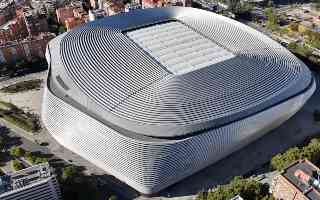
Spain: New Estadio Santiago Bernabéu generates stunning revenue
Although the Estadio Santiago Bernabéu is not yet operating at full capacity, its financial impact on Real Madrid is already massive. In the first six months of the season, the club earned almost as much from non-matchday activities as it did throughout the entire previous season.
-
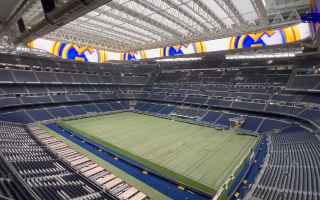
Spain: Real Madrid forced to demolish part of the stands at Bernabéu
Accomplishing dreams requires sacrifices and Real Madrid knows this. Because of hosting an NFL match at the new Santiago Bernabeu, it must adapt the facility to the rules of American football and the needs of the players. To make that happen, the lower rows of the newly completed stands will be demolished, as well as… the changing rooms.
2024
-
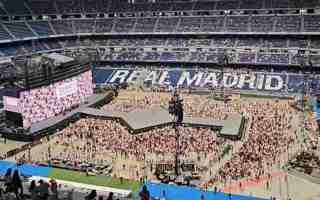
Spain: 24 noise violation fines issued for Bernabéu events!
Since April 26, 2024, the Madrid City Council has imposed a total of 24 penalties amounting to €2.6 million on the organizers of various concerts held at the Santiago Bernabéu Stadium for exceeding permissible noise levels.
-
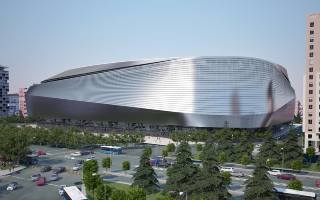
Spain: Santiago Bernabéu closest to hosting 2030 World Cup final!
FIFA has officially confirmed Spain, Portugal, and Morocco as hosts of the 2030 World Cup. The decision on which stadium will host the final is expected soon, with Santiago Bernabéu in Madrid emerging as the favorite.
-
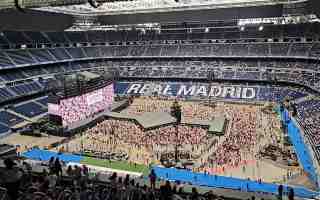
Spain: New complaint against Real for noise at Bernabéu
The Neighborhood Association, the Association of Music Promoters, and now FACUA. The list of enemies of the new Bernabéu is getting longer and longer, and the pressure on Real Madrid and the City Hall is mounting.
-
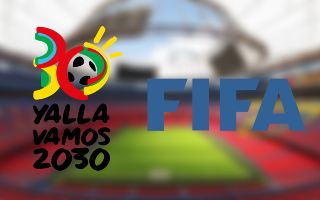
FIFA: World Cup 2030 stadium evaluation. Camp Nou in the lead
Of the 23 stadiums to host the 2030 World Cup matches, as many as 14 either exist only on paper or will undergo deep redevelopment before the tournament. Nevertheless, FIFA has evaluated each of them before the Extraordinary Congress, which will already make its final decision on December 11. Also the one about the final arena.
-
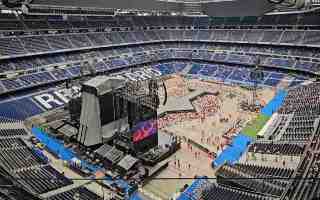
Spain: Artist announces, Real Madrid denies—Bernabéu still without concerts
Lola Índigo announced via a video on her social media platforms that she would perform at Santiago Bernabéu on June 14, 2025. Following the controversies surrounding the cancellation of previously mentioned concerts, this announcement seemed to signal the return of music to Real Madrid’s stadium. However, it turns out not to be true.
-
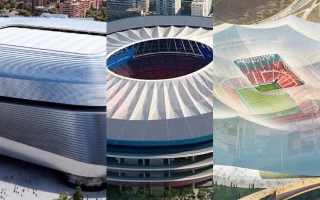
FIFA: Madrid, Barcelona, Morocco - three locations for 2030 World Cup final
The race to host 2030 World Cup finals is on, and three cities remain in play: Madrid, Barcelona and Benslimane. Each offers unique strengths, making FIFA's choice potentially one of the toughest ever. What is in favour of each candidate?
-
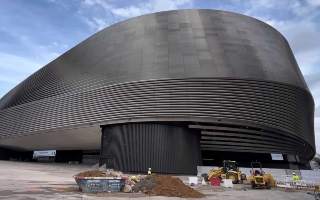
Spain: Florentino Pérez on Bernabéu concerts and collaboration with Apple
Florentino Pérez shed light on key topics at the Real Madrid 2024 General Assembly - from the transformation of the Santiago Bernabéu, to the controversy surrounding the organisation of concerts, to the groundbreaking ‘Infinite Bernabéu’ collaboration. What is behind the name of the new project?
-
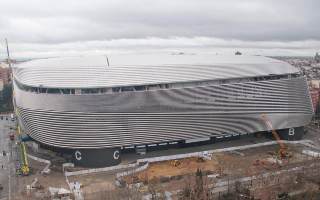
Spain: Madrid leaves clues about Bernabeu inauguration
Despite the fact that there is still a lot of work to be done in the Fondo Sur and around the stadium, Real Madrid has left some important indications between the lines that allow us to foresee when the club will officially inaugurate the new Bernabeu. The club also made it public that the price of the works has gone up once again.
-
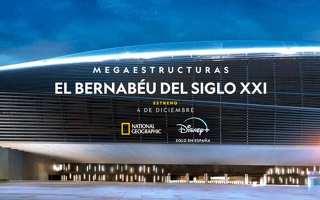
Spain: National Geographic to show documentary on Bernabéu
On December 4, Disney+ and National Geographic will release the documentary 'Megastructures: the Bernabéu of the 21st century', showcasing the behind-the-scenes story of the transformation of Estadio Santiago Bernabéu.
-
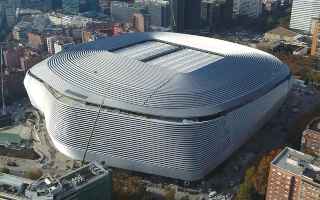
Spain: New Bernabéu; stadium of the future blocked by its neighbours
Real Madrid's temple impresses with its futuristic facade, the video scoreboard, the hypogeum or the retractable roof. However, it is involved in a dispute with neighbors that seems to have no end and damages the image of the best stadium in the world, arguably. Let’s find out who is to blame for the failure of its model.
-
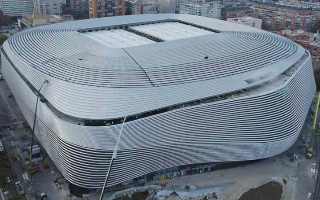
Spain: That's left to complete the new Bernabéu
Architectural Digest España conducted an interview with the architect of the new Bernabéu, Markus Pfisterer. The German assessed the management of the works and the project, but also talked about what remains to be remodeled at Real Madrid's temple, uncovering one of the reasons why the stadium has not been yet officially reopened.
-
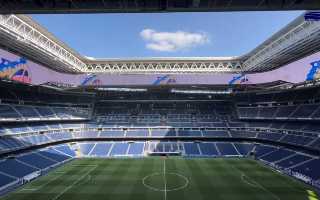
Spain: Real Madrid invests in soundproofing Santiago Bernabéu
Real Madrid has commissioned British firm Arup to carry out acoustic studies at the Santiago Bernabéu. The work is designed to enable concerts to be held without disturbing the residents around the stadium.
-
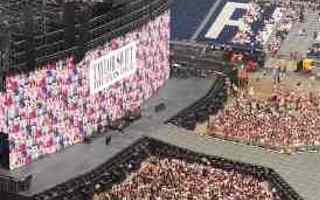
Spain: Music Promoters Association responds to Real Madrid’s accusations
The Music Promoters Association (APM) has issued a statement defending concert promoters who organized events at Estadio Santiago Bernabéu, countering accusations leveled by stadium officials.
-
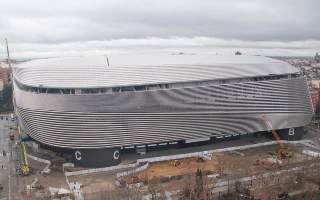
Spain: First hearing in Santiago Bernabéu noise complaint case
On October 29, the first hearing was held regarding a complaint filed by the Neighborhood Association of Those Affected by Bernabéu against Real Madrid. The hearing was attended by Florentino Pérez’s close associate, Jose Ángel Sánchez.
-
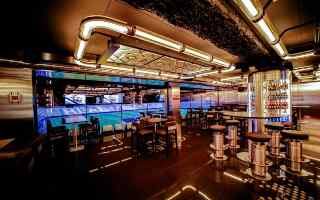
Spain: Mahou opens its brewery at Bernabéu
"Welcome to the place where every toast tastes even more special". With this slogan opens Plaza Mahou, the first brewery in Spain to be located in a football stadium.
-
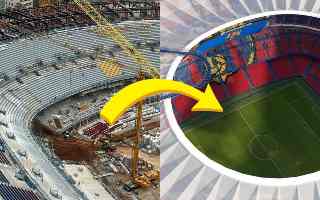
Spain: Wave of stadium upgrades sweeps through the Iberian Peninsula
In recent years, work on Spanish stadiums has not stopped, and the 2030 World Cup has provided another important impetus for the renovation of facilities. With work on the Bernabéu, Camp Nou and Balaídos already underway, 9 La Liga venues are awaiting their turn. Rosaleda, Romareda, Riazor and La Cartuja join the group as 2030 World Cup hosts.
-
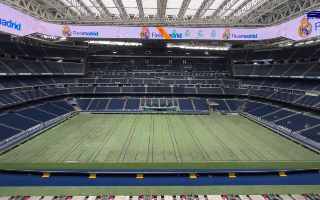
Spain: New Bernabéu is generating one problem after another for Madrid
First, the noise. Then, the license. And now, the report from the firefighters. Real Madrid has a hard time defending their decisions regarding the new Bernabéu, which is losing credibility ahead of the 2030 World Cup final and is gradually shifting from the jewel in the crown to a serious headache for Florentino Pérez.
-

Spain: Bernabéu and Camp Nou for sale in pieces
The stadiums of the two eternal rivals, Real Madrid and FC Barcelona, are undergoing extensive renovations. The works not only reopen the debate about who has the best stadium in Spain, but also open up a unique opportunity for fans to buy parts of the two emblematic grounds.
 StadiumDB
StadiumDB